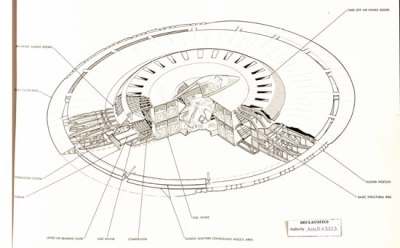Oct 11 2012
Recently declassified documents from the 1950s reveal plans to build a flying saucer.
 Project 1794 Design. Image Copyright: National Archives
Project 1794 Design. Image Copyright: National Archives
The information was discovered in a paper entitled "Project 1794, Final Development Summary Report" dated 1956, according to a blog post published by the National Declassification Center, a branch of the US National Archives.
Though details of the proposed craft have been around for some time, the declassified papers include new data that demonstrates the scale of the project's ambition. The report reveals that in the same year of the dated paper, the Air Force had contracted Canadian company Avro Aircraft Limited in Ontario to construct the concept.
Flying Saucer Declassified
The aircraft, with take-off and landing abilities, was designed to reach Mach 4, a ceiling of over 100,000 feet and maximum range of about 1,000 nautical miles.
Recently declassified records from the Aeronautical Systems Division, USAF (Records of United States Air Force Commands, Activities, and Organizations) unveiled the images of the aircraft.
Though the sketch bore strong resemblance to depictions of flying saucers in science fiction at the time, the report suggests that it would operate as designed, with the National Archives concluding that the project was at least in the initial research and development phases.
"It is concluded that the stabilization and control of the aircraft in the manner proposed - the propulsive jets are used to control the aircraft - is feasible and the aircraft can be designed to have satisfactory handling through the whole flight range from ground cushion take-off to supersonic flight at very high altitude," according to the report.
"Additional tests to completely substantiate this performance are shown to be required." The images also appear very similar to reported UFOs at the time. Interestingly, the Air Force was actively denying the existence of extra-terrestrial life when this plan was undertaken.
The estimated cost, back in June 1956 was $3,168,000, for a period of 18 months to two years. This translates to about $26.6 million today.
The Canadian aeronautical engineers developed a prototype model, named Avrocar, of the project, but it was scrapped in 1961 after poor performance.